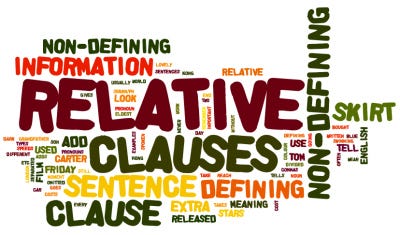Relative clauses
A relative clause is one kind of dependent clause. It has a subject and verb, but can’t stand alone as a sentence. It is sometimes called an “adjective clause” because it functions like an adjective—it gives more information about a noun. A relative clause always begins with a “relative pronoun,” which substitutes for a noun, a noun phrase, or a pronoun when sentences are combined.
We use relative clauses to give additional information about something without starting another sentence. By combining sentences with a relative clause, your text becomes more fluent and you can avoid repeating certain words.
| Pronoun | Stands For | Uses |
|---|---|---|
| who | people | substitutes for subject nouns/pronouns (he, she, we, they) |
| whom | people | substitutes for object nouns/pronouns (him, her, us, them) |
| whose | people or things | substitutes for possessive nouns/pronouns (his, hers, our, their) |
| that | people or things | can be used for either subject or object can only be used in restrictive relative clauses (see below) |
| which | things | can be used for either subject or object can be used in non-restrictive relative clauses can also be used in restrictive relative clauses, though some people don’t like this use |
Diference between defining and non difining
As the name suggests, defining relative clauses give essential information to define or identify the person or thing we are talking about.. The defining relative clause gives us that information. If the defining relative clause were removed from the sentence, the sentence would still be gramatically correct, but its meaning would have changed significantly.
Defining relative clauses are composed of a relative pronoun (sometimes omitted), a verb, and optional other elements such as the subject or object of the verb. Commas are not used to separate defining relative clauses from the rest of the sentence. Commas or parentheses are used to separate non-defining relative clauses from the rest of the sentence.
As the name suggests, non-defining relative clauses tell us more about someone or something, but the information in these clauses does not help us to define what we are talking about. If the non-defining relative clause were removed from the sentence, the sentence would still be grammatically correct and the meaning would not have changed, although we would have less detail.
Non-defining relative clauses are composed of a relative pronoun, a verb, and optional other elements such as the subject or object of the verb. Commas or parentheses are always used to separate non-defining relative clauses from the rest of the sentence.


